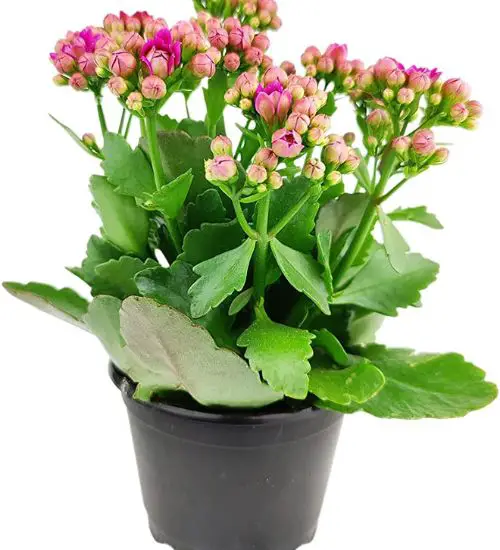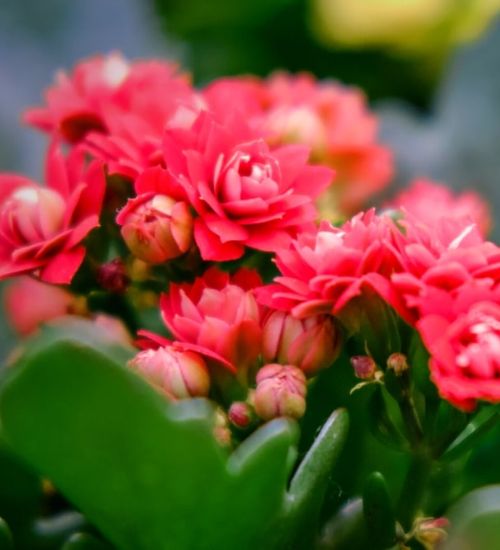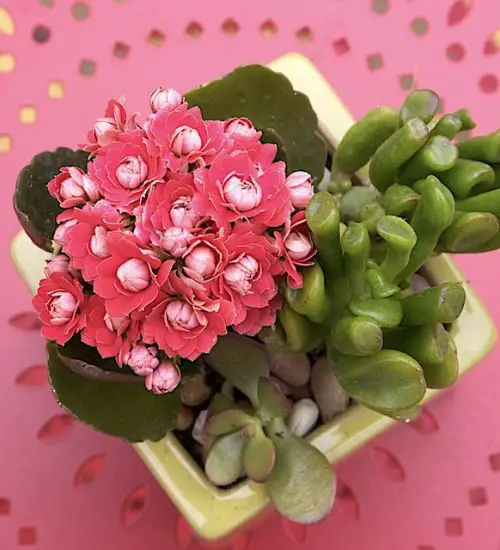Sun: Bright indoor light
Water: Typical water needs for a succulent
Temperature: Zone 10a from 30° F to 35° F (-1.1 ° C to 1.7° C) to Zone 11b from 45° F to 50° F (7.2° C to 10° C)
Winter Survival: Not cold hardy
Propagation: seeds, division
Flower: in the Winter.
Flower Type: Yellow, Orange, pink, salmon colored, white or cream
Toxic: Toxic to humans and animals
Dormant: summer
Space Requirement: Indoors & Outdoors
Common Problems: pests
Where to buy Kalanchoe blossfeldiana (calandiva) floriferous?
Basc Care for Kalanchoe blossfeldiana (calandiva) floriferous
Watering
Watering for Kalanchoe blossfeldiana (calandiva) floriferous is a simple task. It requires Typical water needs for a succulent.
One simple tip for you is that you can use some online apps to check the soil status before you go water your succulents. I would recommend the ThePlantsCheck app, it has some nice features there.
Fertilizing
Only feed this succulent during its active growing seasons which means winter. Use the right fertilizer applied in the right amounts. Applying half-strength balanced fertilizer every month or so is recommended for optimal results.
Do not fertilize during summer as the plant is dormant.
Sun & Location Requirements for "Kalanchoe blossfeldiana (calandiva) floriferous"
Kalanchoe blossfeldiana (calandiva) floriferous needs lots of sunshine! An ideal spot is near a window that gets direct sun for a few hours every day. If you don’t have natural sunlight indoors, consider investing in an LED grow-light to provide enough light for Kalanchoe blossfeldiana (calandiva) floriferous to stay healthy and vibrant.
As per this succulent profile, it is only able to stay healthy when the environment temperature is above the range of zone 10a from 30° F to 35° F (-1.1 ° C to 1.7° C).
Kalanchoe blossfeldiana (calandiva) floriferous is not cold hardy and does not survive in freezing conditions. However, there are certain strategies that can be used to help the plant thrive despite the chill of winter. Proper drainage and insulation are essential for succulent X during periods of extreme cold. Placing a layer of mulch or gravel on the soil around the plant can also help keep it warm.
Any succulents in the group will need a medium space to grow. You can place your pot at your table or window. Since this plant needs more space than mini succulents, you should consider do not plant them together with other succulents/plants.
Kalanchoe blossfeldiana (calandiva) floriferous also benefits from some indirect light throughout the day as well, so make sure you give it enough space to soak up light without becoming too exposed to heat.
Propagation
Growing Kalanchoe blossfeldiana (calandiva) floriferous from seeds is an easy and economical way to produce more plants. Identify a healthy seed by its plumpness, dark color and slightly sticky texture. Once the potting mix has been pre-mixed with well-draining soil, sow the seeds evenly and press lightly into the surface. To ensure germination, keep the container in bright but indirect light and mist the soil gently with a spray bottle.
Toxicity

The leaves of Kalanchoe blossfeldiana (calandiva) floriferous contain an array of toxins that can lead to symptoms such as abdominal cramps, nausea and even death if ingested. It is essential to keep this plant away from both humans and animals.
Pests and Diseases
Kalanchoe blossfeldiana (calandiva) floriferous can be affected common pests and diseases like most of the other succulents such as aphids and mealybugs.
If you do spot any of pest signs, you can treat your succulent using below methods.
- Aphids: quarantine, clean infected plants, soapy water.
- Mealybugs: quarantine, clean infected plants, soapy water.
Besides that, to prevent serious health issues from happening, keep your succulent in a well-ventilated area and check it regularly for any signs of pests or health problems.


